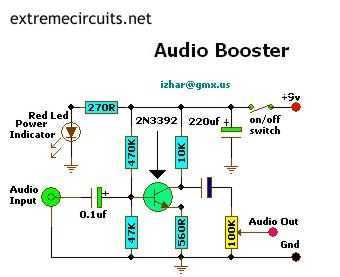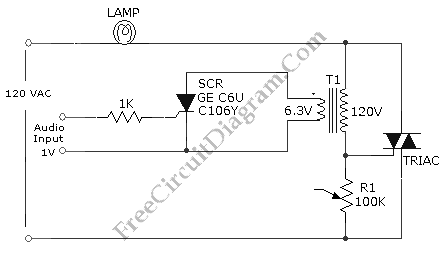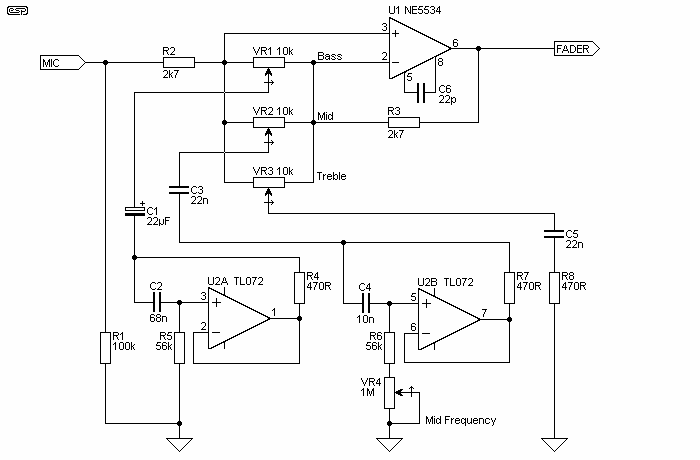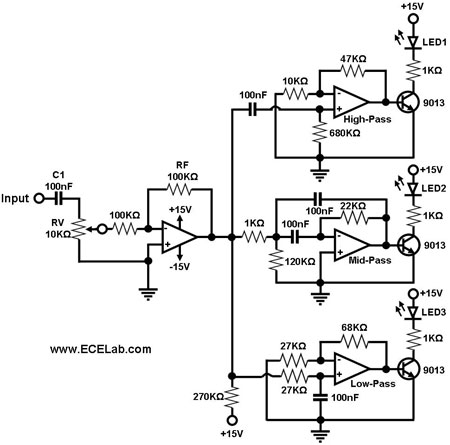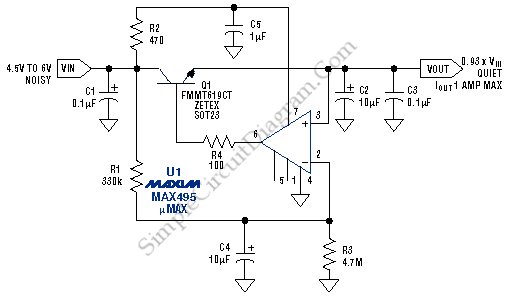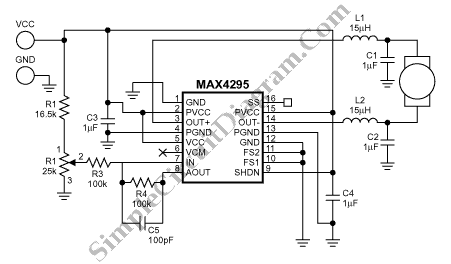
BIQUAD AUDIO FILTER
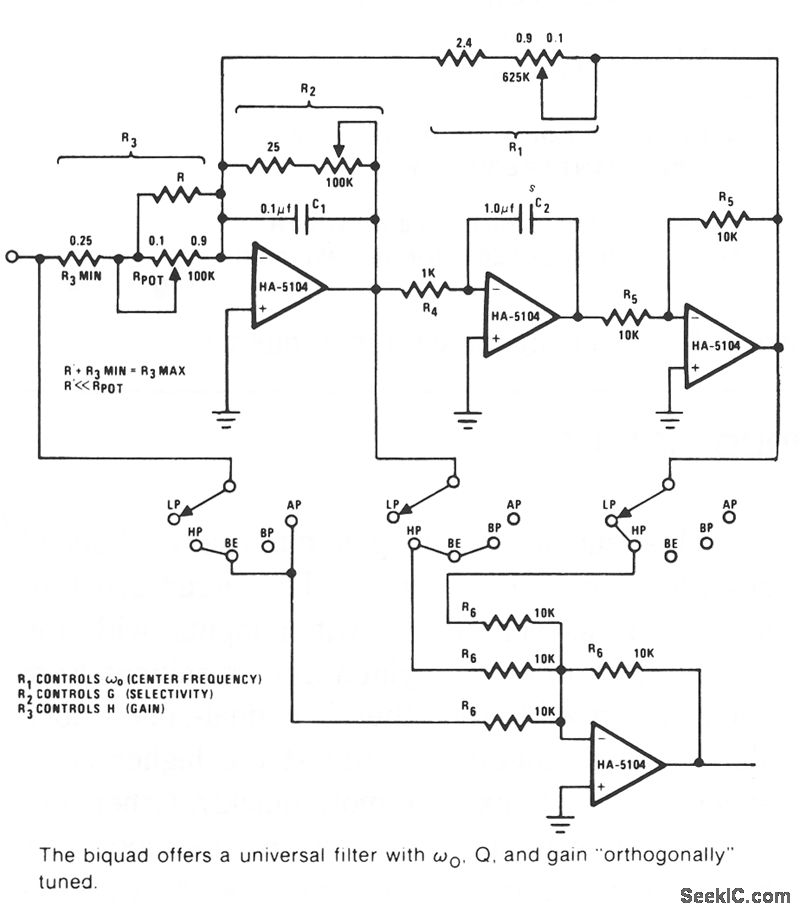
The Biquad consists of two successive integration stages followed by an inverting stage. The entire configuration includes a feedback loop from the front to the back, with resistor R1 primarily responsible for controlling the center frequency, fo. The first stage of integration is a limited integrator due to resistor R2, which restricts the integration range. Resistors R2 and capacitor C form the time constant of the first stage integrator, with resistor R3 impacting the gain H almost directly. The band-pass function is derived after the first stage, while the low-pass function is taken after the third stage. The remaining filter operations are generated through various combinations of the three stages. The Biquad filter is orthogonally tuned, allowing independent adjustment of fo, Q, and gain H. The known component values enable fo to range from 40 Hz to 20 kHz, providing a sufficient operational range for universal filtering in the audio region. The tuning of R1 through R3 allows for independent adjustments of fo, Q, and gain H.
The Biquad filter is a versatile electronic filter configuration that consists of two integration stages followed by an inverting stage. The feedback loop is a critical aspect of its design, as it ensures stability and control over the filter's frequency response. The resistor R1 is pivotal in determining the center frequency, fo, which is the frequency at which the filter exhibits peak response.
In the first integration stage, the performance is limited by resistor R2, which restricts the integrator's range. The combination of resistor R2 and capacitor C establishes the time constant for this stage, effectively defining how quickly the filter responds to changes in the input signal. Resistor R3 plays a significant role as it directly influences the gain H of the filter, allowing for adjustments in the output amplitude.
The Biquad filter's ability to generate both band-pass and low-pass functions is achieved through strategic placement of the filter stages. The band-pass function is taken from the output of the first integration stage, while the low-pass function is extracted after the third stage. This configuration allows for complex filtering operations that can be tailored to specific audio applications.
The orthogonal tuning capability of the Biquad filter is one of its standout features, as it allows for independent manipulation of the center frequency (fo), quality factor (Q), and gain (H). This flexibility is essential for audio applications where precise control over frequency response is required. The component values are designed to facilitate a center frequency range from 40 Hz to 20 kHz, making the Biquad filter suitable for a wide variety of audio filtering tasks. By adjusting resistors R1, R2, and R3 in succession, users can finely tune the filter characteristics to meet their specific needs, ensuring optimal performance in diverse audio environments.The Biquad consists of two successive integration stages followed by an inverting stage. The entire group has a feedback loop from the front to the back consisting of R1 which is chiefly responsible for controlling the center frequency, ‰o. The first stage of integration is a poor integrator because R2 limits the range of integration. R2 and C fo rm the time constant of the first stage integrator with R3 influencing gain H almost directly. The band-pass function is taken after the ftrst stage with the lowpass function taken after the third stage. The remaining ftlter operations are generated by various combinations of three stages. The Biquad is orthogonally tuned, meaning that ‰o. Q. and gain H can all be independently adjusted. The component values known will allow ‰o, to range from 40 Hz to 20 kHz. The other component values give an adequate range of operation to allow for virtually universal filtering in the audio region.
‰o Q. and gain H can all be independently adjusted by tuning R1 through R3 in succession. 🔗 External reference
The Biquad filter is a versatile electronic filter configuration that consists of two integration stages followed by an inverting stage. The feedback loop is a critical aspect of its design, as it ensures stability and control over the filter's frequency response. The resistor R1 is pivotal in determining the center frequency, fo, which is the frequency at which the filter exhibits peak response.
In the first integration stage, the performance is limited by resistor R2, which restricts the integrator's range. The combination of resistor R2 and capacitor C establishes the time constant for this stage, effectively defining how quickly the filter responds to changes in the input signal. Resistor R3 plays a significant role as it directly influences the gain H of the filter, allowing for adjustments in the output amplitude.
The Biquad filter's ability to generate both band-pass and low-pass functions is achieved through strategic placement of the filter stages. The band-pass function is taken from the output of the first integration stage, while the low-pass function is extracted after the third stage. This configuration allows for complex filtering operations that can be tailored to specific audio applications.
The orthogonal tuning capability of the Biquad filter is one of its standout features, as it allows for independent manipulation of the center frequency (fo), quality factor (Q), and gain (H). This flexibility is essential for audio applications where precise control over frequency response is required. The component values are designed to facilitate a center frequency range from 40 Hz to 20 kHz, making the Biquad filter suitable for a wide variety of audio filtering tasks. By adjusting resistors R1, R2, and R3 in succession, users can finely tune the filter characteristics to meet their specific needs, ensuring optimal performance in diverse audio environments.The Biquad consists of two successive integration stages followed by an inverting stage. The entire group has a feedback loop from the front to the back consisting of R1 which is chiefly responsible for controlling the center frequency, ‰o. The first stage of integration is a poor integrator because R2 limits the range of integration. R2 and C fo rm the time constant of the first stage integrator with R3 influencing gain H almost directly. The band-pass function is taken after the ftrst stage with the lowpass function taken after the third stage. The remaining ftlter operations are generated by various combinations of three stages. The Biquad is orthogonally tuned, meaning that ‰o. Q. and gain H can all be independently adjusted. The component values known will allow ‰o, to range from 40 Hz to 20 kHz. The other component values give an adequate range of operation to allow for virtually universal filtering in the audio region.
‰o Q. and gain H can all be independently adjusted by tuning R1 through R3 in succession. 🔗 External reference
